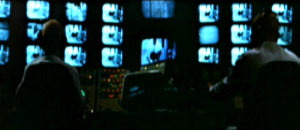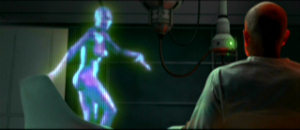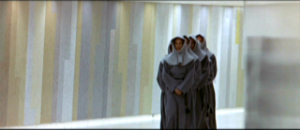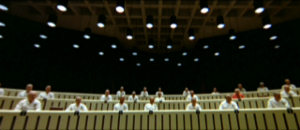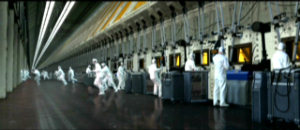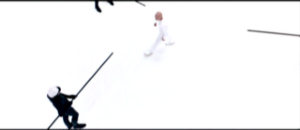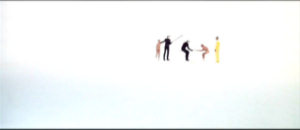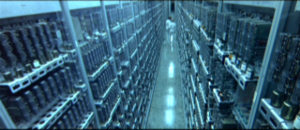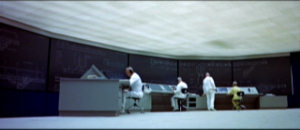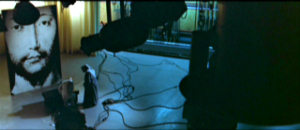|
Unless you live in a distant galaxy and are only here briefly to
study the quaint ways of earthlings, you probably know that THX 1138
was the only commercial feature George Lucas had ever directed
before Star Wars and American Graffiti. You may also know that it is
a Sci-Fi film about a future dystopia and that it is an expansion of
a student film which Lucas had made at USC.
In the film's vision of the future, almost all human
passion and motivation has been suppressed by medication, and humans
live underground in sterile environments. Human names have been
replaced by alphanumeric codes similar to license plate numbers.
Humans look as much alike as possible because their heads are shaved
and they dress alike.
(Like many anti-establishment types from the 60s,
Lucas got a bit mixed up here about exactly what in the
"establishment" he opposed. Just everything, I suppose. On the one
hand, he wanted to show the destruction of individuality, but on the
other hand he wanted to portray the triumph of blind consumerism. It
may be possible to have it both ways, I suppose, but not when it
comes to clothing styles. If capitalism and consumerism triumph,
people will not dress and look alike. You can't make a buck
marketing clothing and hair care if everyone wears the same government-issued
look. To have everyone dressing and living alike is the logical
future extension of socialism, not capitalism. Anyway, back to the
film ...)
THX 1138 is the central character, a man who
manipulates remote robotic arms from behind a radiation shield as he
works with dozens of other drones on a radioactive assembly line to
create the super androids that police their world. He requires even
more meds than normal, because his work is dangerous and
nerve-wracking, and even a tiny mistake can cost many human lives,
as we find out in an establishing scene which shows the result of a
foul-up in an adjoining sector. The workers must be medicated to
keep them from panicking. A reassuring computer voice tells THX and
his colleagues that they should be proud, because his sector has
only lost a few hundred lives, and is so much better than that other
one next door, which has lost twice as many.
The humans of this world are so sedated that police
work is simple. There are no gunfights. Computer voices tell people
when they have committed a crime, and instruct those people to
remain in their present location until they can be escorted away.
They invariably comply peacefully. It works a lot like England.
("Halt ... or ... I'll have to yell 'halt' again.")
THX does his job placidly, and goes home at night to his sterile living
quarters, where he watches lame holographic entertainment. One day,
with no apparent justification, THX's female living companion
decides to cut back on their medication, and as they snap out of
their drugged-out haze, they find sexual and emotional attraction to
one another, which eventually leads to their arrest for criminal
demedication and sexual perversion. (You have to love a world in
which they arrest people for NOT getting high.)
THX is thrown into a strange prison with white walls,
floor, ceiling, and furniture, where he joins other social misfits
in white prison smocks. As it turns out, this prison is largely a
mental trap where the prisoners are convinced they cannot escape,
and drone on endlessly to one another about where they are, how they
would change the world, and who their jailers really are. As it
turns out, escape requires nothing more than simply walking off
toward the unlocked door, then walking out. THX does this, then
conceives of a far grander scheme. Knowing that he cannot stay in
the city, because doing so means entrapment and a return to prison,
THX decides the only route to freedom is to flee the underground
world entirely and to seek the surface. Two other prisoners escape
with him, and the three men meet with very different fates based on
their varying personalities and risk-taking proclivities.
Because the film is some kind of countercultural parable about life
in America in the late 60s and early 70s, it is suffused with moral
consciousness and a general feeling that individuals should not be
suppressed by the state, and all of this is supported by some imaginative
specifics:
-
One of THX's fellow escapees gives up his flight
simply because he fears the unknown more than a return to prison. He
reaches the limits of the city by taking the metro to the end of the
line, then crosses a boundary into some undeveloped, unsterile
place, sees a scorpion there, and realizes he is unprepared for what
lies beyond. He re-enters the sterile area, gets back on the train,
returns to a public square, sits passively, and waits to be apprehended.
-
And what about THX himself? He would have been
apprehended by the pursuers, but he got close to the surface, and
the police department in pursuit ran out of budget, so they simply
ceased the pursuit to prevent cost-overruns. His harvestable organs
were not worth the continuing expense of bringing him in, so the
police looked at their cost-benefit analysis, and called in their
droids. In my mind, that was the single best idea in the whole film.
He didn't escape because of any great heroism or by unrealistically
outlasting some super-powered droids with no need for sleep. He
simply became an expendable asset. The state felt he was no longer worth owning
because the price of capturing him was greater than the benefit of
capturing him,
so he was left to find his future on the surface world.
-
When the film was made it was not generally imagined
that sedation would be so common, and that people would be punished
for not taking drugs. In 2004, with much of the American population
medicated for depression or ADD, this 1971 insight is starting to seem
like a astonishing example of precognition.
Great ideas!
Unfortunately, the great conceptualization is not
supported by enough plot for a feature-length film, so the film
moves glacially, and the minimal plot twists are more symbolic than
real. Moreover, the plot line is not really very interesting, the
characters' actions don't always make sense, and the characters are largely undefined. Some examples
of the problems:
-
It's difficult to believe the specific twists of the
plot because there is no attempt to make the details add up.
-
Could
prisoners really be held securely in an imaginary prison which
resembles Les Nessman's office on WKRP? You mean for centuries
before THX was tossed in the calaboose, all people believed they
couldn't escape just because somebody told them they couldn't? Does
this sound like human nature to you?
-
One of THX's fellow
escapees is a hologram. Are we supposed to believe that a hologram
can really make a transition to
the "real" world and become flesh and blood? Or is this
another case of drug-induced suggestion - something the "hologram"
believes because someone told him so?
-
THX has a reunion with his lover in prison. Did this
really happen, or did he imagine it? If it is real, why did the
State allow it?
-
The prison scene seems to drag on forever, as if the
inmates were characters in a Samuel Beckett play, waiting for some
undefined unknown. This stuff is so flaky it would embarrass Robin
Williams. Maybe even Crispin Glover. OK, maybe not Glover.
So the film is slow, and symbolic, and we can't relate to the
characters. In other words I should have just summed it up for you in one
word. Let's call in Joanne Worley to deliver it, shall we?
"Boooooooooooring!"
And that is no exaggeration. Screaming out "boring"
in the Worley voice is probably going to be your exact reaction. It
is boring, and not a little pretentious. Waiting for Godot acted out
by men in white clothing in an all-white room? Give me a fucking
break!
|
